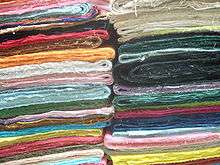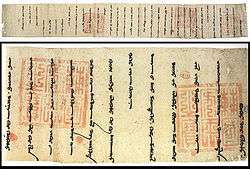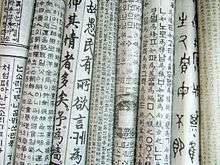Korean paper
| Korean paper | |
 | |
| Korean name | |
|---|---|
| Hangul | 한지 |
| Hanja | 韓紙 |
| Revised Romanization | hanji |
| McCune–Reischauer | hanji |
Korean paper or hanji (Korean: 한지) is the name of traditional handmade paper from Korea.[1][2] Hanji is made from the inner bark of Paper Mulberry, a tree native to Korea that grows well on its rocky mountainsides, known in Korean as dak. The formation aid crucial to making hanji is the mucilage that oozes from the roots of Hibiscus manihot. This substance helps suspend the individual fibers in water.
Traditional hanji is made in laminated sheets using the we bal method (a sheet formation technique), which allows for multi-directional grain[3] The process of creating hanji also employs dochim, a method of pounding finished sheets to compact fibers and lessen ink bleed.[4][5][6][7][8]
History
Ancient
In Korea, papermaking started not long after its birth in China. At first, made crudely out of hemp and ramie scraps (called maji; Korean: 마지), hanji developed to the point that it was renowned as the highest quality paper available in East Asia. Its origins in Korea are believed to fall somewhere between the 3rd century and the end of the 6th century. In 1931, a piece of hanji was found at an archeological dig at a tomb site from the Lelang period (108 BCE–313 CE).
During the Three Kingdoms period (57 BCE–668 CE), each kingdom used paper to record their official histories. In 610, The Buddhist monk Damjing whom Goguryeo presented to Japan was able to make the production method of paper and ink.[9] The world’s oldest surviving wood block print is the Buddhist Dharani Sutra called the Pure Light Dharani Sutra (Korean: 무구정광대다라니경; Revised Romanization: Mugujeonggwangdaedaranigyeong). Listed as Korea's National Treasure No. 126, it was printed onto hanji c. 704 and is still in good condition, bearing the papermaker’s name. Paper crafts were also developed in the Three Kingdoms period, such as kites and other household items, and continued to flourish as hanji production increased. Silla Kingdom, one of the Three Kingdoms, settled the paper industry deeply into Korean culture, and called it Gyerimji, instead of Hanji (“Hanji’s History”).
Goryeo period

Hanji’s golden age peaked in the Goryeo period (918–1392), which saw the rise in quality and use of hanji in conjunction with printmaking. Paper was used to make money, Buddhist texts, and medical and history books. The government encouraged dak cultivation and paper production, and dak was planted countrywide in the 12th century. Often called Goryeoji, hanji became famous in Asia for its strength and luster, and became a heavy trade item to China.
The Goryeo period is famous for two major landmarks in Korean printmaking and paper history. One was the carving of the Tripitaka Koreana onto over 80,000 wooden blocks, which contain no errors and are still extant in their original home at Haeinsa, a Buddhist temple in Gyeongsangnam-do. It was carved twice, due to its destruction by Mongol invasions in 1232; the final version was completed in 1251. The second accomplishment was the printing in 1377 of Jikji, a guide for students of Buddhism, and the world’s oldest extant book printed using metal movable type. Printed onto hanji, it is housed today in the National Library of France, and displays proof of movable metal type well before Gutenberg’s time.
Joseon period
The beginning of the Joseon period (1392–1910) saw continued flourishing of the hanji industry as paper permeated daily lives of Koreans through books, household items, and popular items such as fans and tobacco pouches. From the start of the Joseon period in an effort to promote austerity, artificial flowers that had been made from wax and silk were replaced by paper versions. Later, paper flowers were also used to replace other versions for Buddhist rites and festivals.
Variations of hanji became common, such as colored paper, and paper made from mixed fibers including pine bark, rice straw, and bamboo. This came partly from a need to find new materials beyond dak due to the huge demand for books. The government created an administrative agency devoted to paper production, and also supplied troops with paper armor, which was waterproof, a good insulator, and provided protection against arrows and swords. Oiled hanji was used to make greenhouses c. 1450 because the paper, made of natural materials, could control temperature, humidity, and light effectively. However, the Joseon government pressured Buddhist monks to increase their production of hanji that they were already making for Buddhist scriptures since the 15th century.
As the final blow to hanji, western methods of paper mass production were introduced in 1884.
After liberation
In the 1970s, the New Village Movement that aimed to modernize Korea rapidly also led to further decimation of the hanji industry, as it eradicated traditional straw-thatched homes that used hanji to cover floors, walls, ceilings, windows, and doors. The most recent threat to the Korean paper industry is the rise of inexpensive paper made in China, where labor costs and overhead are significantly lower than in Korea.
As of 2009, twenty-six hanji mills remain operational in South Korea. They make hanji for artists, calligraphers, conservators, temples, and laypeople.[10][11][12][13][14][15]
Manufacturing Process
Materials
The two main materials that are needed when making Hanji are Mulberry Tree (also called Dak tree) and Hibiscus Meniot. More than 6 steps of the manufacturing process deal with mending and preparing the two materials (Seo). The scientific name of a mulberry trees is Broussonetia kazinoki, and it is commonly grown plant in Asia. It grows in the foot of a mountain that gets a lot of sunlight, and its usual growth height is 3m. In Korean history, people used fiber from mulberry trees to hemp clothes, and they began to use it as the source for paper since Goryeo dynasty. Joseon dynasty, which came after Goryeo, recommended people to grow more mulberry trees (“Paper Mulberry”). Hibiscus Manihot usually finishes growing in October. Their roots contain a lot of mucus, a slimy substance that are found in plants, which helps hold the paper together and give viscosity to the bark (“Sunset Hibiscus”).
Process
Ancient Koreans usually started making Hanji during winter, because the mucus from Hibiscus Manihot got easily fermented during the heat in summer (“Sunset Hibiscus”). Also, the ancient Koreans believed that it was important to choose a good day with a nice sky to start making Hanji, and gave religious rituals to the spirits in order to wish for a favorable and smooth process (Seo).
1. Gather the bark of mulberry.
2. Skin the bark of mulberry.
3. Boil the bark of mulberry.
4. Wash the bark.
5. Pound the bark.
6. Pour the mucus from Hibiscus Manihot onto the bark.
7. Form a sheet using sheet formation techniques like the webal method.
8. Dry the sheet.
The process of making Hanji might differ by what ingredients the Hanji makers choose, and what methods of sheet formation they take to make the final Hanji. However, the most traditional and basic process contains the 8 steps mentioned above. After traditional Hanji makers gather the clean and strong bark of a mulberry tree, they dry it, and call it the “Hukpi.” Then the Hukpi is kept in a flowing water for at least 10 hours. This eases the process of skinning the bark, and when the bark is skinned, they call it the “Baekpi.” The next process is boiling the skinned bark, but it does not get boiled in normal water. Instead, they burn bean or buckwheat stem, and puts the ashes into the water to boil Baekpi. After they boil it for 4–5 hours, they go through a tiresome process where they pick any remains of the bark/soil one by one. The next step is to pound Hanji. They place the skinned and cleaned bark on a flat stone board and pound it for about an hour. This process is called Gohae, or more simply put, pounding. The next step is forming the sheet ingredient, while pouring the mucus from Hibiscus Manihot onto the sheet. This mucus helps the paper stay together for a long time, and does not contain any harmful chemicals. They stir the sheet with a long and wooden stick, and they call this Puldaejil. The final substance is put on a flat bamboo outline, where they try to make the surface even and smooth. This process is where the skill of Hanji maker is truly revealed, as it requires years of experience and practice. It is the most important process, because it determines the thickness, the texture, and the overall quality of Hanji. This is the main sheet forming process, and many types of methods exist: Hullim, Gadum, Webal, Jangpan, etc.,.. The traditional method of sheet forming is different from the modern day method, as they did not have machines and technologies to make it even. After this long and challenging process, the Hanji makers get one single paper of Hanji. They press it with heavy stones to dry it, and place the papers in a warm room. They did not dry them near fire, because gradually drying them with a warm temperature was what caused the papers to be tough and durable (Seo). Like this, the overall process of making Hanji was very tiresome. One has to dedicate all of his/her life in making Hanji, and traditional Hanji makers say “I will not let my son be a container man (the person who strains the fiber through a bamboo screen) even if I am driven to the worst” (“The Story”). It requires a lifelong practice to create perfect papers, and this is the reason why Hanji holds a great cultural value in Korea. These days, people use various technology to improve the process. For example, the Hanji makers use heated stainless steel drum, brushing every part of the paper. This is the method that they take to dry the papers evenly, which is adapted from how traditional Hanji makers dried them on the floor of a warm room (Song and Munn).
Characteristics of Hanji
Durability
Hanji is a very reputable paper among Asians, and it is famous for its durability. The fact that other historical print papers have to be preserved in special containers when Hanji papers can still be displayed in museums proves this fact. The oldest text made of Hanji currently existing in Korea, Muggujungwang, is still well preserved after about 800 years (Seo).
Ventilation/Temperature Control
Hanji is a good ventilator, but it also keeps the temperature of the room warm. That is why traditional Koreans covered their wooden doors with Hanji, because it would cool down in the summer and make them warm during winter (Hanji’s History).
Waterproof
In 2006, March, there was a lamp festival in Paris, France. Many sizes and colors of lamps were lighted in the Bologne park. Soon after the festival started, there was a sudden rain, and people panicked. They were worried that all the lamps would turn off. However, lamps made out of traditional Hanji did not turn off. It did not let the rain through, protecting candle lights within, and it portrayed one of the many advantages of Hanji (Seo).
Scientific Principles
The materials that Hanji makers use are unique. Unlike other Asian countries like China, where they use bamboo shoot or yam tree, Koreans used mulberry tree. The bark from mulberry trees contain lignin and holocellulose, which contribute to the durability of Hanji. The ordinary papers that people commonly use have the pH level of 4~5.5. The neutral level that is not harmful to the humans is pH 7, meaning that these papers might be acidic. If papers have low pH level (more acidic), they get completely decomposed in 100 years. Hanji, however, uses Hibiscus Manihot, which has pH level 7, and does not get dismantled easily (“The Significance”).
Use of Hanji
Ancient Uses
Ever since paper was first introduced to the commoners in ancient Koreans, its uses have been adapted into various and unique ways. Hanji was used to help people in the daily lives. They covered their door frame with Hanji and controlled the room temperature. The high social class people, called Yangbans, recorded various documents on Hanji. This is one of the main reasons why Korea’s ancient records are well preserved. China’s Dynasty also only used Hanji to record their emperor’s achievements. It was one of the main export products that Korean dynasties used in trading (Seo). Another unique usage of Hanji is that people made armors out of Hanji. Even though Hanji is just a paper, it was very durable and tough. It was waterproof, and didn’t rip easily. There is a record in Korea saying that people made armors and suits with Hanji, and called them Jigap (“Jigap”).
Hanji art and craft forms
There are two divisions of hanji art: two-dimensional and three-dimensional. Two-dimensional hanji art uses paper of various colors to create an image in a similar format as a painting. However, the paper itself is folded and crumpled to make the image stick up from the paper it is adhered to. People make various shapes with Hanji and frame it to exhibit on their wall. Three-dimensional hanji art is similar to paper mache, in that it can make sculptural objects that may stand unsupported. Traditional hanji craft forms include jiho, jido, and jiseung. Jiho is a method that uses hanji scraps soaked in water and then added to glue, making a clay-like paste that can be molded into lidded bowls. Jido is the craft of pasting many layers of hanji onto a pre-made frame, which can be made into sewing baskets and trunks. Ancient Koreans commonly put their sewing materials in small boxes decorated with colorful Hanji (“Hanji Crafting”). Jiseung is a method of cording and weaving strips of hanji to make a wide array of household goods, including trays, baskets, mats, quivers, shoes, washbasins, and chamberpots. Other than these, Hanji was made into various flowers to decorate Buddhist temples (“Hanji Crafting”).
Gallery
 Changhoji pasted on doors at Changgyeonggung
Changhoji pasted on doors at Changgyeonggung
 Colorful hanji strings; fans
Colorful hanji strings; fans A piece of hanji artwork
A piece of hanji artwork Modern Hanji Lamp
Modern Hanji Lamp
See also
Citations
Cleaning the Bark. Doopedia. Web. 10 March 2016.
"Hanji Crafting." Naver Encyclopedia (Doopedia). Naver, n.d. Web. 17 Mar. 2016.
"Hanji's History." Museum Hanji. Gwasan Hanji Museum, n.d. Web. 7 Mar. 2016.
"Jigap." Naver Encyclopedia (Doopedia). Naver, n.d. Web. 17 Mar. 2016.
Mulberry Tree. Doopedia. Web. 10 March 2016.
"Paper Mulberry." Naver Encyclopedia (Doopedia). Naver, n.d. Web. 13 Mar. 2016.
Seo, Jungho. How to Preserve Cultural Properties. Seoul: Kyungin Publishing, 2008. Print.
Song, Minah, and Jesse Munn. "Permanence, Durability and Unique Properties of Hanji." FIDES International. FIDES International. Web. 2 Mar. 2016.
"Sunset Hibiscus." Naver Encyclopedia (Doopedia). Naver, n.d. Web. 16 Mar. 2016.
"The Significance of Hanji." Naver Encyclopedia (Doopedia). Naver, n.d. Web. 14 Mar. 2016.
"The Story of Hanji." Visit Korea. Korean Tour Organization (KTO), n.d. Web. 6 Mar. 2016.
References
- ↑ http://www.korea.net/korea/event_board_view.asp?board_no=810&page=7
- ↑ http://www.aks.ac.kr/glossary/glossary_detail.asp?g_code=6573&page=1&c_code=&search_field=all&keyword=hanji&order=g_korean&kanada=
- ↑ Lee, Aimee. “Searching for Yupmuljil in the Korean Countryside,” Kami Newsletter, No. 4. Poking, Kapangan, the Philippines: Asa Press (CP), 2009.
- ↑ Traditional Korean Papermaking: analytical examination of historic Korean papers and research into history, materials and techniques of traditional papermaking of Korea, 2003, the research paper of the Getty Postgraduate Fellow, Hyejung Yum
- ↑ Permanence, Durability and Unique Properties of Hanji by Minah Song and Jesse Munn
- ↑ What's Hanji by FIDES International
- ↑ Making Hanji by FIDES International
- ↑ History of Hanji by FIDES International
- ↑ 『日本書紀(Nihon Shoki)』巻二十二 推古紀 "十八年春三月 高麗王貢上僧 曇徵 法定 曇徵知五經 且能作彩色及紙墨 并造碾磑 蓋造碾磑 始于是時歟"
- ↑ Lee, Aimee. “Buddhist Illumination of Korean Papermaking’s Past and Present”, Buddhism and Culture Magazine, No. 5, April 2010.
- ↑ Amlie, Lynn. "Hanji: Korea's Traditional Paper", Hand Papermaking, Vol. 11, No. 2, Winter 1996.
- ↑ Field, Dorothy. Paper and Threshold: The Paradox of Spiritual Connection in Asian Cultures. Ann Arbor: The Legacy Press, 2007.
- ↑ Field, Dorothy. "Kim Yeong Yon: A Korean Papermaker", Hand Papermaking, Vol. 2, No. 1, Summer 1987.
- ↑ Shimura, Asao. "Papermaking in Korea", Kami '89. The Philippines: Cannabis Press, 1992.
- ↑ Sun, Jai-kyu. “100 uses for hand-made paper: Product of ancient Korean art valued for texture, durability”. The Korea Herald. 19 April 1984.
External links
| Wikimedia Commons has media related to Hanji. |
- Hanji (Traditional Korean paper) at Korea Tourism Organization
- Fabulous Hanji (Korean Traditional Paper) at Korea Tourism Organization
- Traditional Culture Hands-on Programs at Korea Tourism Organization